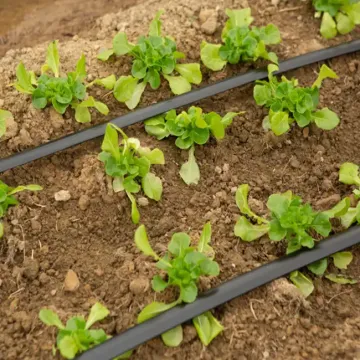Drip irrigation, a method that delivers water directly to the roots of plants, has revolutionized agricultural and gardening practices worldwide. It offers an efficient, sustainable solution to water management in both commercial farming and home gardening. This article delves into the various types of drip irrigation, their benefits, and why this method is a preferred choice for modern gardeners and farmers.
Types of Drip Irrigation
- Surface Drip Irrigation
- Description: This system involves laying drip lines on the soil surface. It is commonly used for row crops and gardens.
- Applications: Ideal for vegetable gardens, flower beds, and orchards.
- Advantages: Easy to install, monitor, and maintain. Suitable for areas with flat or gently sloping terrain.
- Subsurface Drip Irrigation (SDI)
- Description: Drip lines are buried below the soil surface, typically 12 to 18 inches deep.
- Applications: Best for permanent crops like vineyards and orchards, and also used in arid regions to reduce evaporation losses.
- Advantages: Reduces water evaporation and surface runoff. Minimizes weed growth as water is delivered directly to the root zone.
- Emitter Drip Irrigation
- Description: Uses individual emitters that deliver water to specific plants. Emitters can be placed at varying intervals along the drip line.
- Applications: Ideal for spaced plants such as trees and shrubs.
- Advantages: Highly customizable to plant spacing and water needs. Provides precise water delivery.
- Micro-Spray Irrigation
- Description: Combines aspects of drip irrigation and sprinkler systems. Uses small spray heads to distribute water over a broader area.
- Applications: Suitable for ground covers, flower beds, and densely planted areas.
- Advantages: Covers a larger area than traditional drip emitters. Effective for plants with shallow root systems.
- Inline Drip Irrigation
- Description: Incorporates drip emitters into the tubing at set intervals.
- Applications: Commonly used in row crops, vineyards, and landscaping.
- Advantages: Uniform water distribution. Simplifies installation and maintenance compared to emitter systems.
Benefits of Drip Irrigation
- Water Conservation
- Drip irrigation significantly reduces water wastage by delivering water directly to the plant roots. This minimizes evaporation and runoff, making it one of the most efficient irrigation methods available.
- Improved Plant Health
- By providing a consistent moisture level directly to the root zone, drip irrigation promotes healthier plant growth. It prevents water stress and encourages deeper root development.
- Weed and Disease Control
- Since water is delivered precisely where it is needed, the surrounding soil remains drier. This reduces weed growth and lowers the risk of soil-borne diseases.
- Nutrient Management
- Drip systems can be used to deliver fertilizers and nutrients directly to the plant roots. This method, known as fertigation, ensures efficient nutrient uptake and reduces fertilizer runoff.
- Labor and Cost Efficiency
- Once installed, drip irrigation systems require less labor and maintenance compared to traditional irrigation methods. Automated systems further reduce the need for manual intervention, leading to long-term cost savings.
- Adaptability
- Drip irrigation systems can be tailored to fit various landscapes and crop types. They are suitable for both small gardens and large agricultural fields, making them versatile for different applications.
Drip irrigation is a transformative approach to water management in agriculture and gardening. Its various types cater to different needs and landscapes, ensuring efficient and targeted water delivery. The benefits of drip irrigation—ranging from water conservation to improved plant health and cost efficiency—make it an invaluable tool for sustainable farming and gardening practices. By adopting drip irrigation, we can work towards a greener, more productive, and water-efficient future.
Embrace the innovation of drip irrigation and watch your garden or farm flourish with healthier plants and more bountiful yields.

